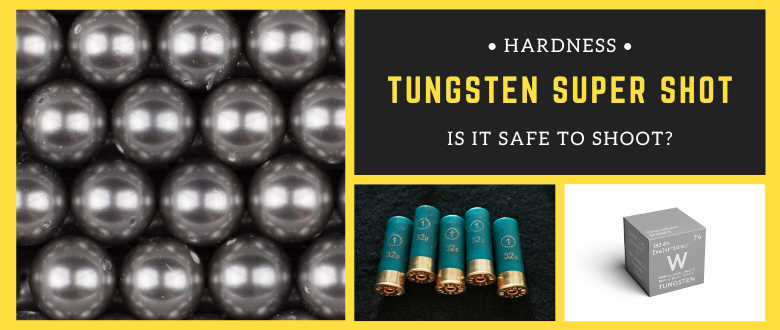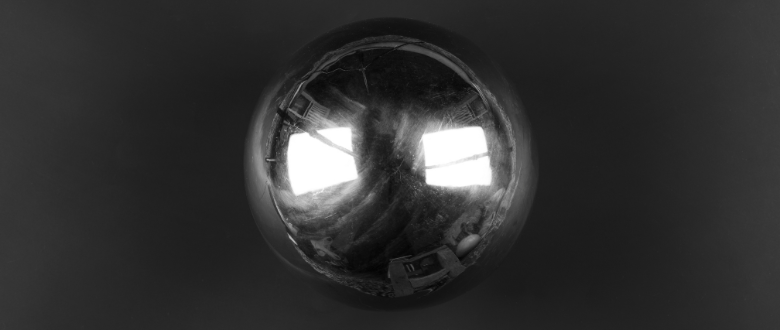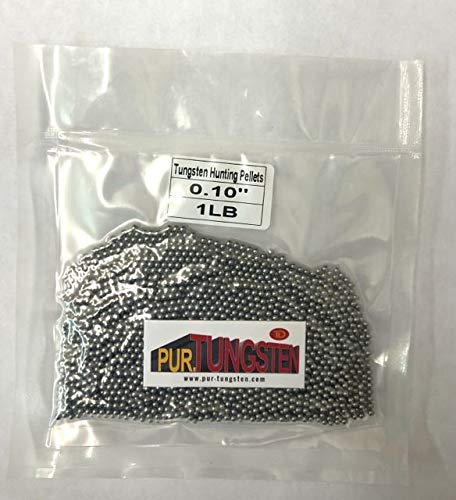QUICK SUMMARY ↬ Tungsten Super Shot is harder than both steel and lead, which makes shotgun barrel damage a real concern. Let’s break down the hardness of TSS – focusing on the Vickers hardness test – while giving tips to reduce the chances of barrel damage occurring with TSS shot.
Tungsten Super Shot (TSS) is a true marvel of modern ammunition technology. What sets it apart from conventional shotgun pellets is its extraordinary density and remarkable hardness. But with that hardness brings the possibility of barrel damage to shotguns that weren’t designed for it.
In this guide, we’ll discuss the hardness of TSS, how it compares to steel and lead, how to make sure it doesn’t damage a shotgun barrel, and the unique challenges it presents to shooting sports.

How hard is Tungsten Super Shot?
TSS is a cutting-edge ammunition material crafted from tungsten alloys. These alloys consist mainly of tungsten, often combined with small amounts of nickel and iron. This potent mixture creates pellets with an unparalleled density (18g/cc), making them ideal for hunting a wide range of game, from waterfowl to big game.
Hardness, in the context of metals, refers to their resistance to deformation or scratching when subjected to external forces. It’s typically measured using standardized scales, with the Rockwell and Vickers scales being among the most common. The harder the material, the higher its rating on these scales. Let’s apply the Vickers scale to TSS.
Hardness and TSS
TSS pellets exhibit exceptional hardness due to the inherent properties of tungsten. Tungsten is one of the hardest natural elements, boasting a Vickers hardness rating surpassed only by diamonds. When combined into TSS alloys, its hardness is slightly reduced but still extremely high.
Hardness in TSS is directly related to the tungsten content. Higher tungsten percentages result in harder pellets. Below is the hardness rating of TSS compared to steel and lead.
Steel: The hardness of steel can vary widely depending on its composition and heat treatment. Common carbon steel, such as mild steel, typically has a Vickers hardness (HV) of around 120 HV to 200 HV. High-strength and tool steels can have much higher hardness values, ranging from 500 HV to 1,000 HV or more.
Lead: Lead is a relatively soft and malleable metal. It has a low hardness compared to steel and tungsten. Lead typically has a Vickers hardness of around 5 HV to 16 HV.
Tungsten: Tungsten is a very hard and dense metal. Pure tungsten has a Vickers hardness of approximately 2570 HV to 2650 HV, making it significantly harder than both steel and lead. Tungsten alloys, such as Tungsten Super Shot, can have varying hardness values depending on the alloy composition but are generally several times harder than both steel and lead.
To see how TSS compares to lead and steel pellets for hunting, see the TSS Pellet Equivalency Chart.
Related Products
Does TSS cause barrel damage?
While TSS’s hardness contributes to its superior performance in downrange impact and penetration, it also presents a challenge. Hard pellets can accelerate wear and tear if they repeatedly make contact with the barrel of a shotgun. Prolonged use of TSS pellets without precautions may lead to barrel damage, including scoring, pitting, and even barrel scratching.
This is more evident on barrels that weren’t designed for hard shot, such as steel or tungsten. Modern shotgun barrels conditioned for use with higher pressures and treated for hard pellets are the best choice to prevent barrel damage from occurring in the first place with TSS.

Mitigating barrel damage with TSS
To minimize the effects of hard pellets on shotgun barrels, shooters can take several precautions. These include regularly inspecting barrels for signs of wear, using compatible choke tubes to control shot dispersion, and avoiding the use of ultra-tight chokes.
Reloaders can use thicker wads and a mylar wrap inside the shotcup to prevent TSS pellets from making contact with the barrel. An overshot card or felt spacer can be inserted over the shot column to prevent TSS pellets from escaping the top of the wad prematurely, a problem that plagued early TSS loads.
Finally, monitoring of spent wads, inner walls of the barrel, and choke should be conducted regularly to identify signs that TSS is traveling outside of the wad so that it can be addressed quickly.
Bottom Line: TSS has a Vickers hardness rating of approximately 2500 HV
Tungsten Super Shot is a game-changing ammunition prized for its density and exceptional hardness. While its performance in the field is second to none, users must be aware of its potential to negatively affect shotgun barrels.
TSS is 200 times harder than lead, and 20 times harder than steel. It’s harder than the barrel of a shotgun itself, which means added protection is often required to avoid the two from coming into contact. Using modern shotgun barrels, thicker wads, mylar wraps, and over shot cards are good ways to prevent TSS pellets from adversely affecting the barrel of a shotgun.
With the right precautions, the benefits of TSS can be enjoyed without compromising the longevity of a shotgun barrel. And with the popularity of TSS continually growing, this means success in the field for years to come.
Was this helpful?
Wondering what TSS is equivalent to? See this comparison versus Steel and Lead Pellets.
Search Chokes by Gauge
Latest Posts
- Best Waterfowl Choke Tubes for 2024, Expert Picks
- Choke Tube Diameter and Constriction Table
- 5 Easy Ways to Remove a Stuck Choke Tube
Last update on 2025-11-27 / Affiliate links / Product Images from Amazon Product Advertising API






